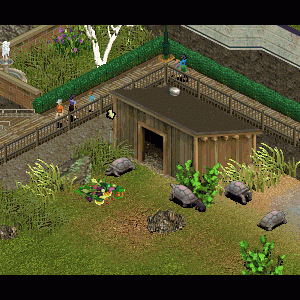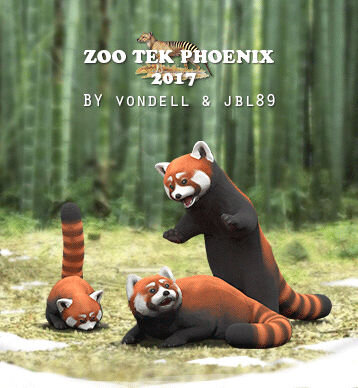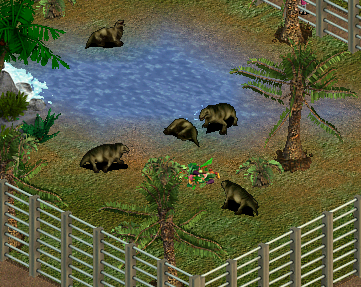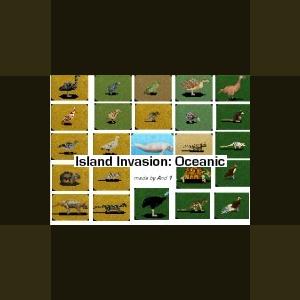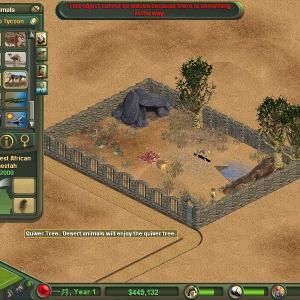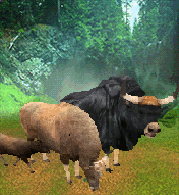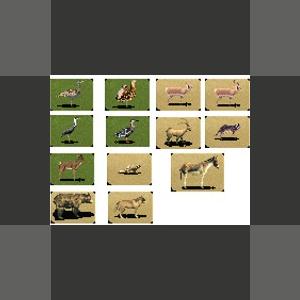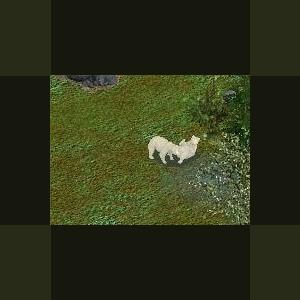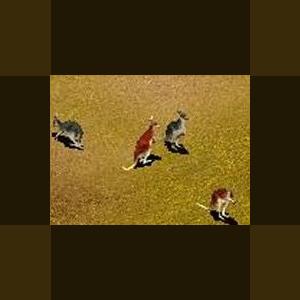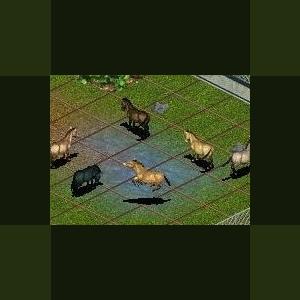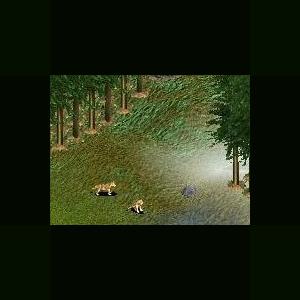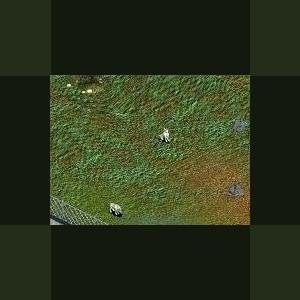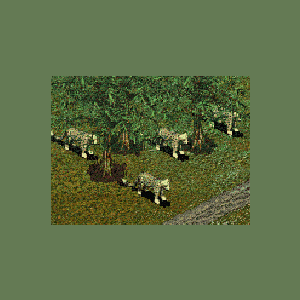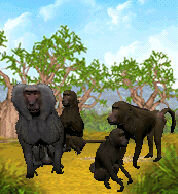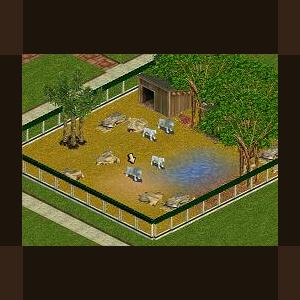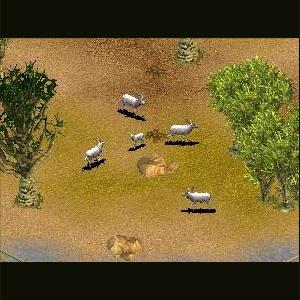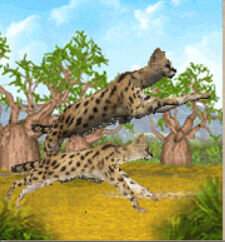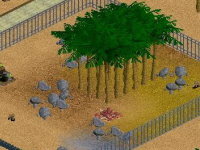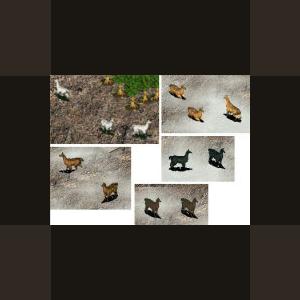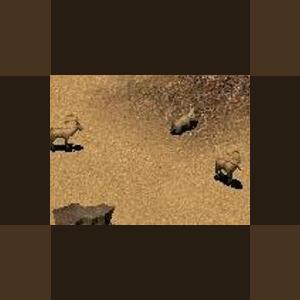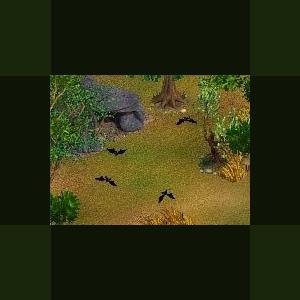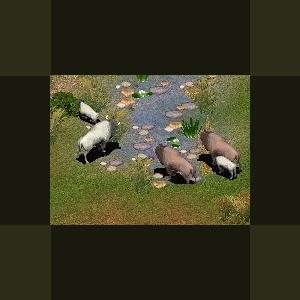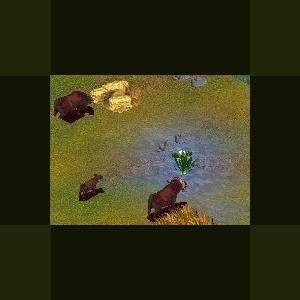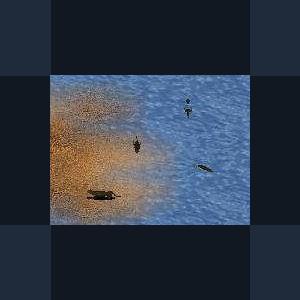279 files
-
Aldabra Giant Tortoise by Vondell
By Cricket
Similar in size to the famous Galapagos giant tortoise but from the opposite side of the earth, the tortoises on the islands of the Aldabra Atoll in the Indian Ocean are some of the largest in the world.
Graphics and animations by Vondell.
Special thanks to Fern and Jay for file checks and assistance.
Please click on the picture to see the animations.
1,646 downloads
Updated
-
Red Panda by Vondell and JBL89
By jbl89
The Red Panda is an original new endangered animal, compatible with Zoo Tycoon 1 (no expansion packs needed).
You might also hear this little critter's unique cry once in a while.
From Wikipedia: The red panda (Ailurus fulgens), also called the lesser panda, the red bear-cat, and the red cat-bear, is a mammal native to the eastern Himalayas and southwestern China. It has reddish-brown fur, a long, shaggy tail, and a waddling gait due to its shorter front legs; it is slightly larger than a domestic cat. It is arboreal, feeds mainly on bamboo, but also eats eggs, birds, and insects. It is a solitary animal, mainly active from dusk to dawn, and is largely sedentary during the day.
- Design by Vondell
- Configuration by Jeff
(to admins: please test this animal once more, I'm using a slightly different version which was stable in my game. Vondell's been active for a bit, but I'm sure he's okay with publishing this first version of the Red Panda)
1,102 downloads
Updated
-
Moschops by P.Rex
By P.Rex
Moschops by P.Rex
Moschops belongs to Synapsida, a group of reptiles ancestral to mammals. It lived during the late Permian period in what is today South Africa. It is a heavily-built herbivore with a massive girth, allowing for fermentation of large amounts of plant matter. It feeds almost exclusively on soft plants, such as ferns, though it may be capable of carnivory in times of extreme famine. Moschops are very timid herbivores that prefer to avoid confrontation, usually fleeing at the first sight of danger.
This Moschops was adapted from the video game "Carnivores" by Action Forms.
625 downloads
Updated
-
White Rhinoceros by Khaydar
By Khaydar
Adopt a White Rhinoceros (Ceratotherium simum) for your zoos.
White Rhinoceros description:
Minimum happiness needed for chance of breeding: 90.
Liked foliage:
Thorn Bush, Umbrella Thorn Tree, Tall Grass
Liked rock:
Large Rock, Small Rock - Medium, Small Rock - Small
Number of animals allowed per exhibit: 1-10 with 50 squares each.
A suitable exhibit for 2 of this animal has 100 squares containing terrain of:
60 Savannah Grass, 10 Sand, 25 Dirt, 5 Fresh Water
using 9 grid squares filled with 4 Tall Grass most liked plant
and using 8 Small Rock - Small most liked rock.
Preferred shelter: Large Stable.
Credits to DutchDesigns for the model and mesh
Made by Khaydar
288 downloads
- living animal
- rhinoceros
- (and 1 more)
Updated
-
Island Invasion Oceanic by And 1
By Guest
The Pack contains 24 animals of the Oceanic Area.
File is in english and german.
Animals included:
Sylviornis neocaledoniae (german: Du)
Numbat
Thorny Devil (german: Dornteufel)
Lace Monitor (german: Buntwaran)
Cape Barren Goose (german: Hühnergans)
Malleefowl (german: Thermometerhuhn)
Spinifex Pigeon (german: Rotschopftaube)
Lesser Bird of Paradise (german: Kleiner Paradiesvogel)
Adzebill (german: Aptornis)
King Island Emu (german: Schwarzer Emu)
Matschie's Tree-kangaroo (german: Matschie Baumkänguru)
South Island Goose (german: Südinsel Riesengans)
Common Wombat (german: Nacktnasenwombat)
Little Spotted Kiwi (german: Zwergkiwi)
Tiger Quoll (german: Riesenbeutelmarder)
Northern Cassowary (german: Einlappenkasuar)
Marsupial Lion (german: Beutellöwe)
Black-spotted Cuscus (german: Tüpfelkuskus)
Weka (german: Wekaralle)
Takahe
Quokka
Meiolania (german: Riesen Hornschildkröte)
Dugong
Western Long-beaked Echidna (german: Westlicher Langschnabeligel)
Updated 2010-11-03
Just to save space with less in zip and smaller image.
Nothing new.
2,061 downloads
Updated
-
Northwest African Cheetah by RDingFT
By Fern
Northwest African Cheetah
Author : RDingFT
Compatibility : All Game Versions
Well I used the cheetah to create a new animal : Northwest African Cheetah :)
To reskin the cheetah, I used Markhor.pal.
The Northwest African Cheetah (Acinonyx jubatus hecki), also known as the Saharan Cheetah, is a subspecies of cheetah found in the northwestern part of Africa (particularly the central western Sahara desert and the Sahel). It is classified as critically endangered, with a total world population estimated to be about 250 mature individuals.
465 downloads
Updated
-
Gaur
By Khaydar
Adopt a Gaur (Bos frontalis) for your zoos.
Favorite plant: Rainforest fern
Shelter: Stable
Biome: Rainforest
278 downloads
- bovid
- khaydars animal
- (and 1 more)
Updated
-
Gobi Pack by And 1
By Guest
Pack which contain 11 animals from the Gobi / Mongolian Area. Made by And 1
The Gobi pack contains 11 animals from the Gobi/ Mongolian area:
Gobi Kulan (German: Gobi Halbesel)
Gobi Bear (German: Gobi Bär)
Gobi Wolf (German: Gobi Wüsten Wolf)
Siberian Ibex(German: Sibirische Steinbock)
Mongolian Gazelle (German: Mongolische Gazelle)
Hooded Crane (German: Mönchskranich)
Przewalski's Gazelle (German: Przewalski Gazelle)
Marbled Polecat (German: Tigeriltis)
Chinese Mountain Cat (German: Gobikatze)
Great Bustard (German: Großtrappe)
Swane Goose (German: Schwanengans)
Files are in both German and English
UPDATED 12/20/2008 to correct the file format.
(German)
Updated 2010-11-03
Just to save space with less in zip and smaller image.
Nothing new
11 Nov 2012. Some players have noted that the bear does not appear ingame and this is how to fix it.
Note from Jay re the Gobi bear:
I put And_1_Gobi Bär.ZTD in my dlupdate folder without anything else and it did not appear in the animal purchase menu. I had to change the "ä" to "a" in the ".ztd" name to get it to appear in the animal purchase menu. I assume that it does appear in And_1's ZT, so it might have to do with the language used by each person's MS Windows.
1,343 downloads
Updated
-
Kermode Bear by Ghirin
By Guest
Kermode Bear
The Kermode bear, also known as the spirit bear, is a rare color phase of the North American black bear. These bears are only found in the temperate coastal rainforests of British Columbia, with most of the population living on Princess Royal Island and Gribbell Island.
Only about one in ten of local bear population is actually the creamy white color of the Spirit bear. The others are the normal colors of the black bear (black, brown, grey, or cinnamon).
Created by Ghirin 2004
Updated 2010-11-03
Just to save space with less in zip and smaller image.
Nothing new.
244 downloads
Updated
-
Dimorphic Red Kangaroo by Ghirin
By Guest
Dimorphic Red Kangaroo
Author: Ghirin
Red kangaroos are the world's largest marsupials. Despite the name, not all red kangaroos are red. In the eastern part of their range, males are usually some shade of red and females are blue-gray; elsewhere, both sexes may be reddish brown. Male kangaroos are called "boomers," female kangaroos are "blue fliers," and young are called "joeys." Red kangaroos are found primarily in the dry grasslands and plains of central Australia. The terrain in this region consists of savannah-like grasses interspersed with barren areas of dry dirt, sand, and the occasional rock. Kangaroos prefer open areas, with a sparse scattering of native bushes and trees for shade. Kangaroos are semi-nomadic, and their movements are not restricted by most types of fencing.
These animals congregate in loose and temporary social groupings, called mobs. Although the makeup of a mob can vary, it will commonly contain a dominant male, several adult females, and young of both sexes. Mothers and young can remain together for years.
Kangaroos are able to survive high temperatures by seeking shade during the day and feeding at night. In the wild, their diet consists of green grass, leaves, and roots. They swallow their food whole, later regurgitating a cud and chewing it. In the wild, this animal does not need continual access to fresh water, as long as green herbage is available. When necessary, they will dig for water. In zoos, kangaroos are fed a diet that typically includes fruit, yams, bread, monkey-dog-guinea pig chow, and vitamin supplements.
Baby kangaroos are bean-sized when born. The tiny, hairless embryo makes its way across the mother's belly into the pouch, where it attaches itself to one of the four available teats. Once nursing begins, the teat swells up so that the baby will remain attached. The joey will remain in the pouch for 5 to 6 months as it continues to mature. After that, it will be fully developed and can emerge to explore. Joeys are usually weaned around one year of age, but will remain close to the mother for another six months.
Kangaroos are so well-designed for hopping that they are unable to walk. They have large, powerful hind feet that cannot move independently of each other and a tendon in their legs that behaves like a rubber band, conserving energy as they move. Red kangaroos can hop as fast as 40 mph, making leaps as long as 29 feet. Kangaroos will run from danger, rather than fight, although a large claw attached to their hind leg makes them quite dangerous at close quarters. The kangaroo's long, heavy tail provides balance and support.
Red kangaroos are shy, alert creatures, docile except when cornered. To warn their mob of impending danger, these animals will thump on the ground. Hearing this warning, joeys will jump back into their mothers' pouches. Although males will not defend the members of their mob from attack, they will fight each other for breeding rights. The two boomers will attempt to push each other off balance by jabbing or locking forearms. Sometimes they will lean back on their tails and kick each other in the belly with their powerful hind feet.
Foxes and eagles prey on very young kangaroos. Dingoes prey on young and adult alike. Because of the damage they can do to crops, kangaroos are considered pests and are destroyed accordingly. Red kangaroos are also commercially hunted for skins and meat. This animal is considered a threatened species.
Updated 2010-10-30
Just to save space with less in zip and smaller image.
Nothing new.
341 downloads
Updated
-
Horse Pack by Jordan
By Guest
Horse Pack by Jordan
Six colors of horses that will live happily together. Includes: bay, black, buckskin, palomino, sorrel and roan horses.
Updated September 8, 2023 by Jay to show the preferred foliage tooltip for the female and young, to correct the behaviors broken by APE, to remove unnecessary files and configuration lines, to add some spacing in the animal info, and to include a combined ztd.
Updated 2010-11-03
Just to save space with less in zip and smaller image.
Nothing new
639 downloads
Updated
-
Nordic Lynx by Jordan
By Guest
Nordic Lynx by Jordan
Made by Jordan and dedicated to Jane
Updated 2010-11-04
Just to save space with less in zip and smaller image.
Nothing new.
449 downloads
Updated
-
Westie by Jordan
By Guest
Westie by Jordan
The incredibly adorable West Highland White Terrier of Scotland. Dedicated to Paul and Snowy.
Updated 2010-11-11
Just to save space with less in zip and smaller image.
Nothing new.
170 downloads
Updated
-
Amur Leopard by Gemma
By Guest
Amur Leopard by Gemma (ZTU Belgium)
Surveys in 200 estimated that there were fewer than 50 of these animals left in the wild. the critically endangered animal faces problems from loss of its food source, loss of habitat and from human conflict.
This amur leopard was created by our great designer Gemma and it likes to live in the forest with mixed floors and forest trees. What do you want more to live in? Great animal!
Compatible with all versions.
Updated 2010-10-30
Just to save space with less in zip and smaller image.
Nothing new.
Updated: 6th January 2013 by JohnT and Jay:
The ZTU Amur Leopard was updated to not crash when used in a non-English Zoo Tycoon, to disallow it being placed on water terrain being that it does not have swim graphics, to like all Coniferous objects which is its preferred habitat, to add sounds for when it is picked up or put down, to add the preferred foliage tooltip for the female and young, to change its location to Southeast Asia, to make its configuration more efficient, to remove unused files, and to correct some grammar in the animal info.
618 downloads
Updated
-
Hamadryas Baboon
By Khaydar
Adopt an Hamadryas Baboon (Papio hamadryas) for your Zoos
Hamadryas Baboon description:
Minimum happiness needed for chance of breeding: 95.
Liked foliage:
Acacia Caffra Tree, Savannah foliage
Liked rock:
Large Rock, Small Rock - Medium, Small Rock - Small
Animal can jump.
Animal can climb objects.
Animal can climb cliff.
Number of animals allowed per exhibit: 3-20 with 15 squares each.
A suitable exhibit for 3 of this animal has 45 squares containing terrain of:
22 Savannah Grass, 9 Sand, 5 Dirt, 7 Brown Stone, 2 Fresh Water
using 5 grid squares filled with 4 Acacia Caffra Tree most liked plant
and using 25 Small Rock - Small most liked rock.
Preferred shelter: Large Concrete Shelter.
258 downloads
- khaydars animal
- living animal
- (and 1 more)
Updated
-
White Lions by JohnT (JohnRN1)
By Fern
Thank you for downloading the White Lions. These rare white creatures are dedicated to our friend Caddie for his love of animals. Enjoy.
"Move the .ztd file into the dlupdate (and not dupdate) folder if one exists in your Zoo Tycoon folder; otherwise move the .ztd file into the Updates folder that is in the Zoo Tycoon folder."
The default is C:\Program Files\Microsoft Games\Zoo Tycoon
Thank you to Fern and Jay for their invaluable encouragement guidance, and expertise. And, thanks to in game testers at DD.
--JohnT--
444 downloads
Updated
-
Addax by Taz (Tasmanian_tiger)
By Fern
Addax
Author : Taz (Tasmanian_tiger)
Category : Critically endangered animal, Bovid, Antelope
Updated: July 20, 2013 by Jay to correct 1 animation view, to remove unnecessary files and configuration lines, to correct a configuration mistake done by the APE program concerning sounds, to make some minor adjustments to the animal info, and to make it like the Addax Family Rock as much as its most liked in-game rock. Please note that the version at Taz's site is no longer the most current version, since she is deceased.
Current ztd date: July 20, 2013
Compatibility : All Game Versions
Description : The Addax is a large antelope with a gray-brown coat that during the summer changes to white. Addaxes belong to a group of antelope with horse-like characteristics. This group is unique in that females have horns the same size as the males'. These antelope are similar to caribou in body structure and both have broad, flat hooves. These hooves enable the addax to travel great distances over sand and stone.
622 downloads
Updated
-
Serval
By Khaydar
Adopt a Serval ( Leptailurus serval) for your zoos.
Animal guide:
Minimum happiness needed for chance of breeding: 97.
Liked foliage:
Savannah foliage
Liked rock:
Large Rock, Small Rock - Medium, Small Rock - Small
Animal can jump.
Animal can climb cliff.
Number of animals allowed per exhibit:
1-2 with 18 squares each.
A suitable exhibit for 2 of this animal has 36 squares containing terrain of:
26 Savannah Grass, 4 Sand, 4 Dirt, 2 Fresh Water
using 6 grid squares filled with 4 Tall Grass most liked plant
and using 19 Small Rock - Small most liked rock.
Preferred shelter:
Large Burrow.
Other liked items:
Waterfall Rock
377 downloads
- living animal
- khaydars animal
- (and 1 more)
Updated
-
African Ruppell's Fox (Sand Fox) by Ghirin
By Guest
African Ruppell's Fox By Ghirin
The sand fox (Vulpes ruppelli), also known as Ruppell's fox, is native to arid and semi-arid regions in northern Africa, Arabia and central Asia, including stony desert, steppes, thornbush savannah, and dry woodland. They have a distinctive call, a "wow" sound ending in two yaps.
Sand foxes live in pairs or small family groups. They build dens, but also tend to move to a new location about once a week. Sand foxes hunt at night, preying on small mammals, insects, fruit and carrion.
Created by Ghirin 2004
Updated 2010-10-30
Just to save space with less in zip and smaller image.
Nothing new.
Updated August 18, 2018 by Cricket so that screenshot would show up again.
626 downloads
Updated
-
Alpaca Pack by Ghirin
By Guest
Alpaca Pack by Ghirin
This pack contains 5 extremely well-designed alpacas by Ghirin. They are: fawn, brown, dark brown, black, and white. All 5 alpacas are compatible with one another and with the official llama.
The alpaca (Lama pacos), a relative of the llama, is a domesticated camelid from the Andes Mountains of South America. Unlike the llama, the alpaca has been bred for its wool and is much smaller than the llama. The wool of the alpaca is among the finest in the world, bested only by that of the vicuna and certain breeds of goat.
Alpacas come in two wool varieties, suri and huacaya. The wool of the suri alpaca is finer and straighter than that of the huacaya. It falls in locks along the sides of the suri alpaca. The huacaya alpaca is more common than the suri; its wool is crimpy and gives the huacaya a "teddy bear" appearance. The wool of either variety comes in several colors, from white to black.
The peoples of the Andes domesticated the ancestors of the alpaca approximately 5000 years ago and these animals were used as a source of wealth.
*Inspired by the Zoo Tycoon Brains Trust at the Zoo Tek Zoo Tycoon Forums.
Updated 2010-10-30
Just to save space with less in zip and smaller image.
Nothing new.
693 downloads
Updated
-
Nubian Ibex by Ghirin
By Guest
The Nubian ibex (Capra nubiana, Capra ibex nubiana) is native to far northeastern Africa and western Asia. It is a small member of the ibex family and is sandy brown color. Its habitat is the dry, rocky areas of the middle east, with the sandy-colored coat providing reflector for solar radiation.
Unlike many desert animals, the Nubian ibex needs to drink everyday.
*Inspired by the Zoo Tycoon Brains Trust at the Zoo Tek Forums.
Created by Ghirin 2005
Updated 2010-11-04
Just to save space with less in zip and smaller image.
Nothing new.
290 downloads
Updated
-
Pemba Flying Fox by Genkicoll
By Guest
The Pemba flying fox is a large fruit bat weighing 400 - 650 g (0.9 - 1.4 lb). Its diet consists of the fruit and flowers of a number of plants.
Primary and secondary forest, graveyards and mangroves provide roosting sites. The Pemba flying fox is very social and has been found in large colonies until recently.
The Pemba flying fox is found only on Pemba Island, Tanzania. The island was originally forested, but only remnants of the primary forest remain. Estimates of the status of the Pemba flying fox have varied considerably recently. Studies in 1989 suggested a dramatic population decline, with fewer than 10 individuals being seen, and the species was considered to be on the brink of extinction. However, in 1992, surveys indicated a population in the region of 2400-3600, although it was estimated that the population may have declined significantly in the preceding decade. (Entwistle & Corp 1997)
Habitat loss from deforestation is a major concern, since the last fragments of natural forest are now in danger of disappearing (Seehausen 1991). Pemba islanders hunt bats only for subsistence purposes, not for commercial purposes. Currently, the villagers appear mainly to use traditional hunting methods. If the use of shotguns increases, hunting could become more of a threat.
Source: Professor Paul's Nature Encyclopedia
Many thanks to Ziggy for the original gif animations.
Updated 2010-11-05
Just to save space with less in zip and smaller image.
Nothing new.
488 downloads
Updated
-
Buffalo and White Buffalo by Genkicoll
By Guest
These buffalo are very happy in the same exhibit, which is more visually interesting than the in-game bison's exhibit. You can now add wallows or a few hills if you like, as well.
Buffalo
The largest mammal on the North American continent, a healthy adult buffalo needs to have little fear of predators. However, a peacefully grazing animal can change without warning into a snorting, pawing, 2,000-pound threat, with a menacingly lowered head and stiffly upraised tail. Buffalo can charge at speeds over 30 mph. Both male and female buffalo have massive heads, which are not only equipped with lethal horns, but are also effective as battering rams.
Buffalo at rest may be seen rolling and wallowing. Wallows created by buffalo are shallow, dust-filled depressions, and were once a common feature of the plains where they roamed in large numbers. Buffalo live near gravel-lined streams amongst the gently rolling hills and plains of Northern America.
White Buffalo
The Legend of the White Buffalo:
"One summer a long time ago, the seven sacred council fires of the Lakota Sioux came together and camped. The sun was strong and the people were starving for there was no game.
Two young men went out to hunt. Along the way, the two men met a beautiful young woman dressed in white who floated as she walked. One man had bad desires for the woman and tried to touch her, but was consumed by a cloud and turned into a pile of bones.
The woman spoke to the second young man and said, "Return to your people and tell them I am coming." This holy woman brought a wrapped bundle to the people. She unwrapped the bundle giving to the people a sacred pipe and teaching them how to use it to pray. "With this holy pipe, you will walk like a living prayer," she said. The holy woman told the Sioux about the value of the buffalo, the women and the children. "You are from Mother Earth," she told the women, "What you are doing is as great as the warriors do."
Before she left, she told the people she would return. As she walked away, she rolled over four times, turning into a white female buffalo calf. It is said after that day the Lakota honored their pipe, and buffalo were plentiful." - from John Lame Deer's telling in 1967
These animals are fully compatible, and are programmed to like Catfish's small stones, Paardjee's green grass, Sundance's prairie foliage (not released yet), and several user-made shelters. These animals do NOT need a shelter, but they won't object to having one, either. Also shown in screenshot are some of Genki's Tall Grasses, which are exhibit-neutral.
UPDATED October 15, 2008 to make compatible with Genki's Night Mare and Day Mare, to fix a small error in the .ucs, and to make the buffalo like exhibit-neutral items.
Updated 2010-10-30
Just to save space with less in zip and smaller image.
673 downloads
Updated
-
Hereford Cow by Genkicoll
By Guest
Made by request, a special surprise for Menolly.
The Hereford breed was founded some two and one-half centuries ago as a product of necessity. Thrifty and enterprising farmers near Hereford in the County of Herefordshire, England, were determined to produce beef for the expanding food market created by Britain's industrial revolution. To succeed in Herefordshire, these early-day cattlemen realized they must have cattle which could efficiently convert their native grass to beef and do it at a profit.
There was no breed in existence at the time to fill that need, so the farmers of Herefordshire founded the beef breed that logically became known as Herefords. These early Hereford breeders molded their cattle with the idea in mind of a high yield of beef and efficiency of production, and so firmly fixed these characteristics that they remain today as outstanding characteristics of the breed.
Beginning in 1742 with a bull calf from the cow Silver and two cows, Pidgeon and Mottle, inherited from his father's estate, Benjamin Tomkins is credited with founding the Hereford breed. This was 18 years before Robert Bakewell began developing his theories of animal breeding. From the start, Mr. Tomkins had as his goals economy in feeding, natural aptitude to grow and gain from grass and grain, rustling ability, hardiness, early maturity and prolificacy, traits that are still of primary importance today.
Other pioneering breeders were to follow the Tomkins' lead and establish the world-wide renown for the Herefordshire cattle causing their exportation from England to wherever grass grows and beef production is possible.
Herefords in the 1700's and early 1800's in England were much larger than today. Many mature Herefords of those days weighed 3,000 pounds or more. Cotmore, a winning show bull and noteworthy sire, weighed 3,900 pounds when shown in 1839. Gradually, the type and conformation changed to less extreme size and weight to get more smoothness, quality and efficiency.
Source: http://www.ansi.okstate.edu/breeds/cattle/hereford/
*NOTE: 100% compatible with the prairie peafowl by Genki and the silkies made by Sundance.
Updated 2010-11-03
Just to save space with less in zip and smaller image.
Nothing new
464 downloads
Updated
-
North American River Otter by Ghirin
By Guest
North American river otters (Lontra canadensis) are semi-aquatic members of the weasel family. They can be found in any location where both permanent access to food and clean, open water. While mainly thought of as inland animals, these otters can be found in coastal habitats such as estuaries.
North American river otters are usually solitary animals, but groups composed of a mother and her young are often seen exhibiting playful behaviors such as mud and snow sliding.
Like most otters, North American river otters are fish eaters.
*Inspired by the Zoo Tek Brains Trust at the Zoo Tek Forums
References:
Ellis, E. and T. Dewey. 2003. "Lontra canadensis" (On-line), Animal Diversity Web. Accessed June 24, 2004 at http://animaldiversity.ummz.umich.edu/site/accounts/information/Lontra_canadensis.html.
http://www.press.jhu.edu/books/walkers_mammals_of_the_world/carnivora/carnivora.mustelidae.lutra.html
http://www.lioncrusher.com
Created by Ghirin 2004
Updated 2010-11-04
Just to save space with less in zip and smaller image.
Nothing new.
742 downloads
Updated

